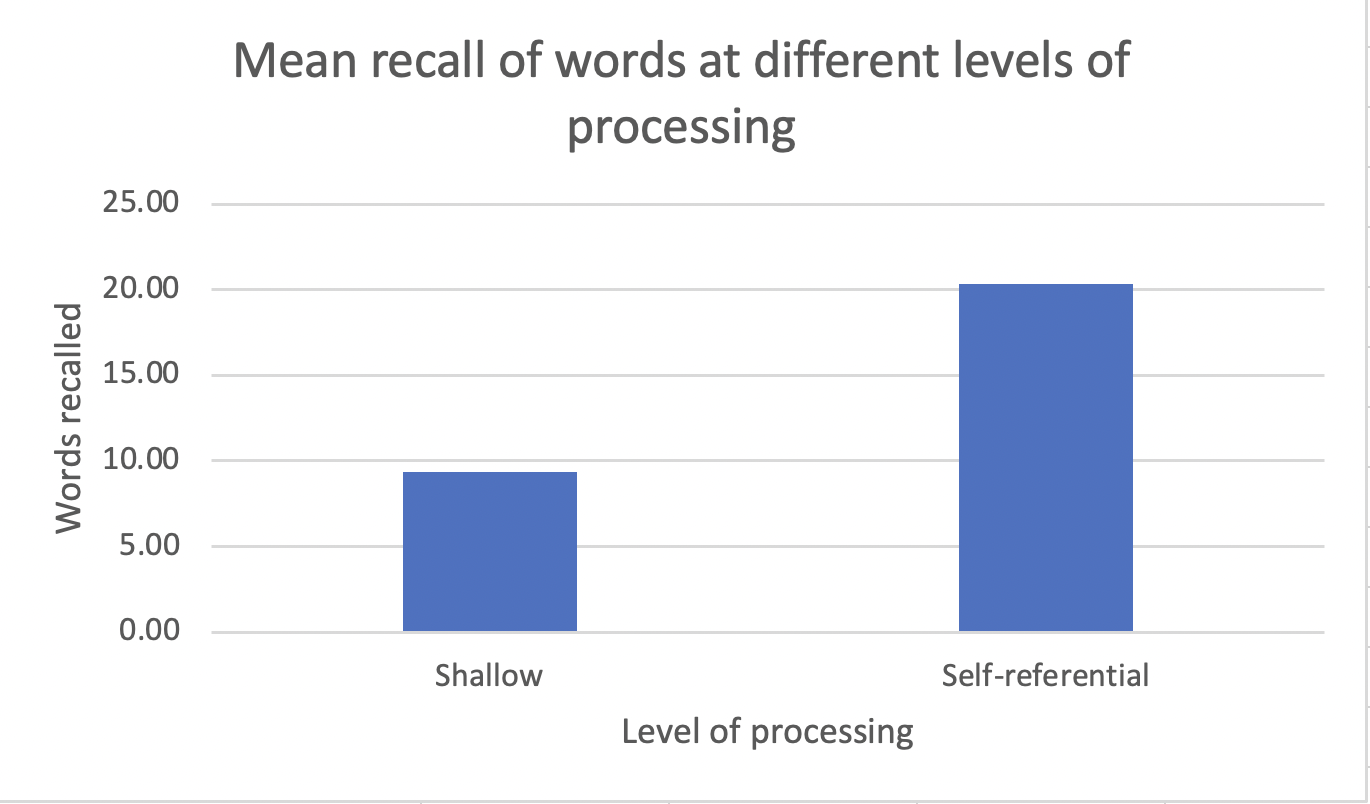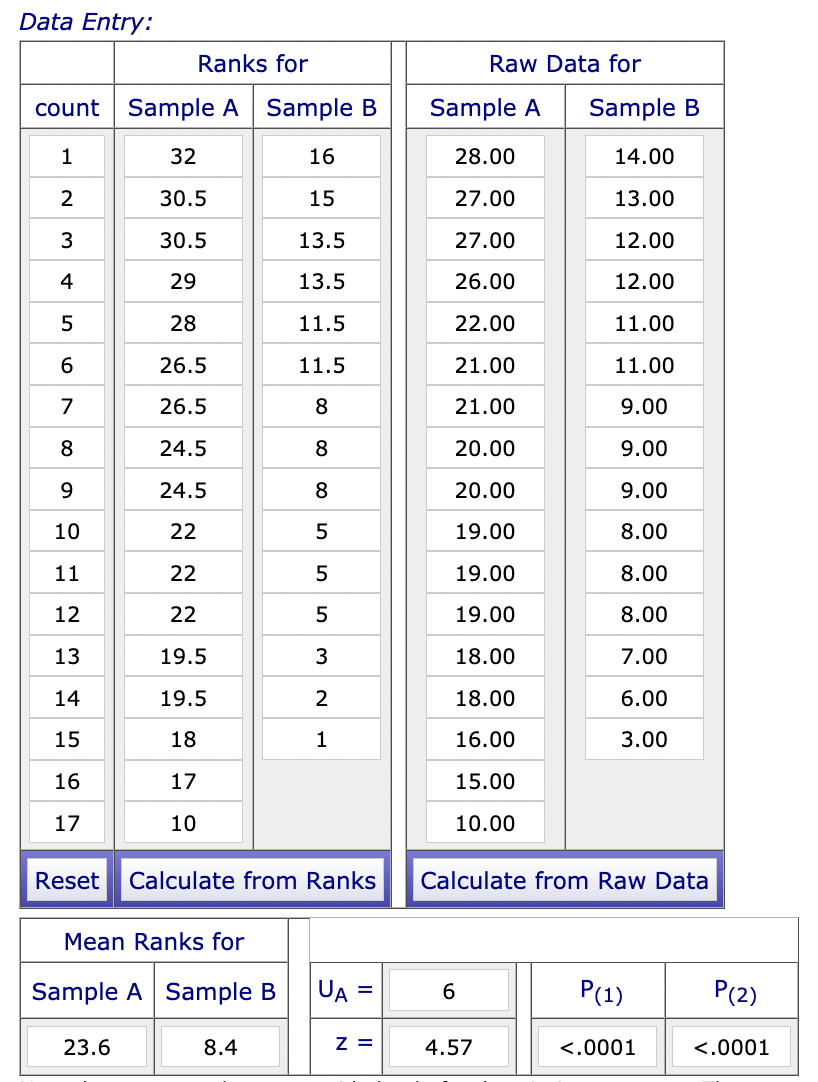IA Exemplar Medium
 The sample below is one of three exemplars that I will be using with my students. They are all from the same experiment, but one is a "high", one is a "mid" and one is a "low" scoring internal assessment.
The sample below is one of three exemplars that I will be using with my students. They are all from the same experiment, but one is a "high", one is a "mid" and one is a "low" scoring internal assessment.
The experiment by Rogers, Kuiper and Kirker (1977), which focuses on the self-reference effect, can be found here.
The appendices do not include the letter of consent, materials, or the debriefing notes. The appendices do include the raw data and statistical calculations. Failure to include raw data or statistical calculations is penalized in the analysis.
Introduction
Craik & Tulving (1975) proposed what is known as the “Levels of Processing Theory.” This theory argues that “the way information is encoded affects how well it is remembered. The deeper the level of processing, the easier the information is to recall.” (McLeod). The researchers distinguish between “shallow” and “deep” processing. Shallow processing can either be structural or phonemic. Structural processing asks about the physical properties of something. The researcher could ask “does this word have more than five letters?” Phonemic processing asks something about the sound of the word. It may be whether the word rhymes with cat. Shallow processing only uses maintenance rehearsal – that means that there is no elaborative rehearsal. The deep processing is semantic. That means that the meaning of the word is reflected upon. This helps us to remember words.
Rogers, Kuiper and Kirker (1977) carried out a study on deep processing. In order to get the participants to think deeply, they asked them to personalize the words. They called this “self-referent processing.” Their sample was made up of 32 first year psychology students. Participants were asked either a shallow processing question or a deep processing question such as “Does this describe you?” while watching a list of 40 words being projected. The results were that participants who processed the words more “deeply” remembered significantly more words than those participants in the shallow condition.
The aim of our study is to replicate this study and see if deep processing increases one’s ability to recall a list of words. The deep processing will be to ask them the question “Does this describe you?” as was asked in the original study. This study is important to replicate because we need to see if we can get the same results. In addition, we want to know if this could help us to memorize more efficiently.
The null hypothesis is that there will be no difference in the number of words recalled if a participant uses shallow processing or deep processing.
The research hypothesis is that there will be a difference in the number of words recalled if when participants use shallow processing or deep processing.
Exploration
Our study used an independent samples design. One group was asked to process the list of words shallowly (does the word have an “E?”) and the other group was asked “does this word describe you?”.
Our sample had 32 participants - with 15 in the shallow processing condition and 17 in the deep condition. Both groups met at the same time but were in different rooms with a different member of our team. We used a sample of opportunity because it was available. They were two classes of IB English. A sample of opportunity uses a sample that already exists in order to make it easier to obtain a sample. All participants were asked to sign a letter of consent (see Appendix i)
For our materials we created a list of forty words. The words were all adjectives that could be used to describe people. The list made more sense for our experiment than a list of random words since we were asking one group if the word described them. We put the words into a Powerpoint presentation and had each word projected to the participants for 15 seconds.
In each condition, participants were read the standardised directions (see Appendix ii). After the list was complete, participants were shown the video “Funny Animal Videos” as a distractor task. This was to make sure that the participants would not simply recall the words because they were the last words on the list. After the distractor task, participants were given two minutes to write down as many words as they could recall. When the time was up, they were thanked for their participation and debriefed them. (see app vi).
Analysis
After all data was collected, both descriptive and inferential statistics were done to see if our data was significant. The descriptive statistics are in the table below.
Table 1. Descriptive statistics
| Shallow processing | Deep processing | |
| Mean | 8.86 | 21.29 |
| Median | 7.0 | 22.0 |
| Standard deviation | 4.33 | 7.96 |
The mean of the deep processing group that was asked to think about how the word related to them personally was 21.29, while the mean of the group that did shallow processing was only 8.86 words. This means that the deep processing condition remembered on average 12.43 more words than the group that only had to think about the structure of the word. This is not due to outliers. Even if we take out the top two scores in the deep processing group so that the group sizes would be even, in the shallow processing group the median score was 7 words – meaning just as many participants scored above 7 as below 7; in the deep processing group the median was 22. There was more variance in the deep processing group, maybe because some people didn’t understand the directions.

Because we used an independent sample design, we used a Mann Whitney U test. The results were significant at p < 0.0001. This means that we can reject our null hypothesis. It appears that when we think about how words are personally relevant to us and therefore process the information deeply, we can remember significantly more words than when we process the words shallowly.
Evaluation
Our replication of Rogers, Kuiper & Kirker (1977) was successful. We found that those participants who did self-referential, deeper encoding were able to recall significantly more words than the group that was asked structural questions. This matched the findings in the original study. It appears that there are different levels of processing that the deeper the level, the better we are able to recall a list of words.
Asking students to think about how much the word describes them is asking them to do elaborative rehearsal. The idea is to create a sense of meaning for the words so that they are easier to recall. This strategy appears to be successful in this experiment.
There were several limitations of our study. One of the problems is that we used an independent samples design. One of the problems with this design is that one group may tell the members of the other group what the experiment is about. This is called contamination. In our study, however, we had both groups go at the same time, so we did not have any contamination. However, it is not possible for us to say that both groups had exactly the same experience because different researchers carried out the experiment with each group.
We used an opportunity sample made up of students. They may have been unmotivated to do their best in the study. Another problem is that we cannot generalize the students to a larger population. Students are used to memorizing lists of words so they are not like other people.
Another limitation of the study was that the study lacks ecological validity. Experiments are done in laboratories and thus are highly artificial. This means we cannot generalize the results outside of the laboratory.
Another limitation is that we had a very small sample and the size of the two groups was not the same. If we were to do the study again, we would want to have a larger sample in order to make our results more reliable.
For future research, it would be interesting to see if thinking about yourself leads to deeper processing than other forms of deep processing – for example, mental imagery. It could be that making personal connections is even more important than trying to create images, which has been shown in the past to produce higher levels of recall.
From our study we are able to conclude that deep processing in the form of self-referential encoding has greater recall of words than when the words are processed at a structural level.
Works cited
Craik, F. I. M., & Tulving, E. (1975). Depth of processing and the retention of words in episodic memory. Journal of Experimental Psychology: General, 104, 268-294.
McLeod, Saul. (2007). Levels of Processing. Simply Psychology. Accessed January 14, 2015. Available at: http://www.simplypsychology.org/levelsofprocessing.html
Rogers, T. B., Kuiper, N. A., & Kirker, W. S. (1977). Self-reference and the encoding of personal information. Journal of Personality and Social Psychology, 35, 677-688.
Appendix i. Raw data
| Shallow | 8 | 12 | 14 | 11 | 9 | 7 | 12 | 8 | 3 | 13 | 9 | 6 | 8 | 9 | 11 | ||
| Self-referential | 22 | 28 | 19 | 15 | 21 | 19 | 16 | 10 | 27 | 19 | 27 | 21 | 18 | 20 | 26 | 20 | 18 |
Appendix ii. Inferential calculations

Assessment
Introduction
The study and theory are described but not well linked. The aim is stated but imprecise. Relevance is identified but not explained in any detail. The IV and DV are implied in the hypotheses, but they are not operationalized. 3 marks
Exploration
The research design is described in satisfactory detail. The sampling technique is defined rather rather than described. Minimal characteristics of the sample are identified. Controls are identified and there is some description and justification, but most often they are simply stated. The choice of materials is described, but not explicitly justified. 2 marks
Analysis
Statistics are not correctly applied. The hypothesis is two-tailed but the Mann Whitney results are stated in terms of a one-tailed test. The statements about taking out two pieces of data in order to make the groups equal is not acceptable practice. The variance is described in limited detail and not explained correctly. The graph distorts data and could be more clearly labelled. The full range of the y-axis should be used since the range of potential responses was limited. The conclusion is not correctly stated with regard to the inferential statistics. Since the hypothesis was two-tailed we cannot conclude that one condition would have significantly more than the other. 3 marks
Evaluation
The findings are described with reference to the background study and/or theory. Limitations are not always linked to the research, but are more general or superficial in nature. There is a concern about the statement, "it is not possible for us to say that both groups had exactly the same experience because different researchers carried out the experiment with each group." Modifications are not always described. An idea for further research is described. 4 marks
Total marks: 12 marks

 IB Docs (2) Team
IB Docs (2) Team
